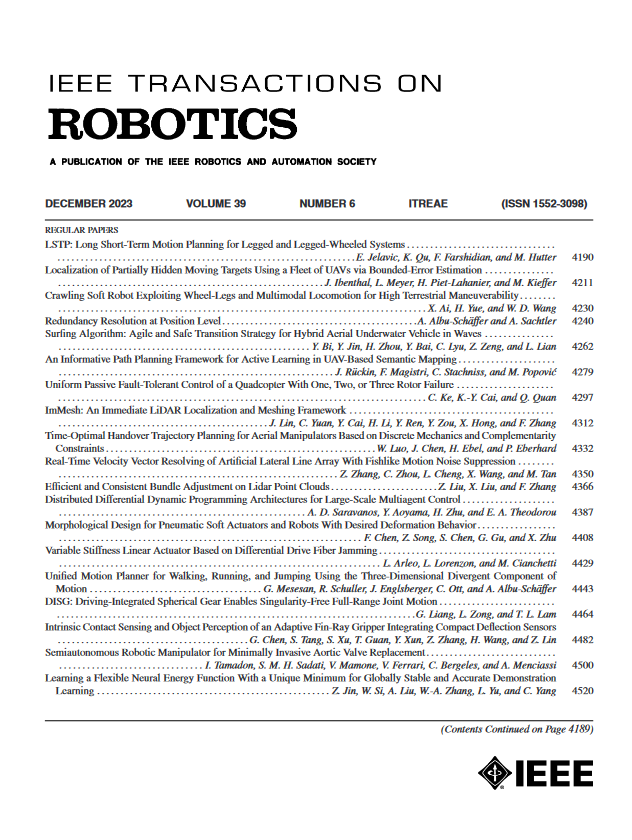零信任自主感知任务下基于雷达的弱扩展目标联合抗干扰检测与跟踪
IF 9.4
1区 计算机科学
Q1 ROBOTICS
引用次数: 0
摘要
扩展目标检测和跟踪(EODT)正在成为自主感知的一个有前途的替代方案,它不仅提供常见的运动状态,还提供准确的空间范围信息,如形状和大小估计。然而,由于在零信任自动驾驶场景中雷达传输不协调,基于雷达的EODT系统受到攻击者发射的相互射频(RF)干扰,导致幽灵目标和噪音增加。为此,本文提出了一种新型的弱扩展目标联合抗干扰检测与跟踪系统。与前人将目标检测和跟踪作为两个独立的步骤进行处理不同,本文提出的方法通过将连续的检测过程整合到跟踪中,将两者联合处理,提高了弱目标的可检测性。更具体地说,为了适应雷达反射的时变数量和扩展尺寸,采用了代表可变形范围的自适应空间分布模型来捕捉轮廓随时间的演变。该方法通过累积反射功率,将所有后向散射点视为一个实体来匹配真实目标,从而避免了棘手的数据关联问题。与基于随机矩阵模型的方法不同,该方法将运动和程度状态分解为独立的部分,该研究探索了状态之间的相互依赖关系,并同时更新它们。此外,该系统已部署在低成本的汽车雷达平台上。实验结果表明,该方法可以实现准确、弹性的EODT,抵抗射频干扰攻击,特别是在遮挡、动态运动切换和复杂的多扩展目标跟踪场景下。本文章由计算机程序翻译,如有差异,请以英文原文为准。
AiDT: Toward Radar-Based Joint Anti-Interference Detection and Tracking for Weak Extended Targets Under Zero-Trust Autonomous Perception Tasks
Extended object detection and tracking (EODT) is becoming a promising alternative for autonomous perception, which provides not only common motion states but also accurate spatial extent information, such as shape and size estimations. However, due to uncoordinated radar transmissions in zero-trust autonomous driving scenarios, radar-based EODT systems suffer from mutual radio frequency (RF) interference launched by attackers, leading to ghost targets and increased noise. On this account, a novel joint anti-interference detection and tracking system for weak extended targets is presented in this article. In contrast to pioneering works that treat object detection and tracking as two separate steps, the proposed method handles them jointly by integrating a continuous detection process into tracking, improving the detectability of weak targets. More specifically, to accommodate the time-varying number and extended size of radar reflections, an adaptive spatial distribution model representing the deformable extents is incorporated to capture the contour evolution over time. The key insight is that by accumulating the reflected power, all backscattered points are regarded as one entity to match the real target so that the intractable data association problem can be circumvented in the proposed method. Unlike the prominent random matrix model-based approaches that split motion and extent states into independent parts, this study explores the interdependencies between the states and updates them simultaneously. In addition, the proposed system has been deployed on a low-cost automotive radar platform. Experimental results confirm that the proposed approach can achieve accurate and resilient EODT against RF interference attacks, especially in occlusion, dynamic motion switching, and complex multiple extended target tracking scenarios.
求助全文
通过发布文献求助,成功后即可免费获取论文全文。
去求助
来源期刊

IEEE Transactions on Robotics
工程技术-机器人学
CiteScore
14.90
自引率
5.10%
发文量
259
审稿时长
6.0 months
期刊介绍:
The IEEE Transactions on Robotics (T-RO) is dedicated to publishing fundamental papers covering all facets of robotics, drawing on interdisciplinary approaches from computer science, control systems, electrical engineering, mathematics, mechanical engineering, and beyond. From industrial applications to service and personal assistants, surgical operations to space, underwater, and remote exploration, robots and intelligent machines play pivotal roles across various domains, including entertainment, safety, search and rescue, military applications, agriculture, and intelligent vehicles.
Special emphasis is placed on intelligent machines and systems designed for unstructured environments, where a significant portion of the environment remains unknown and beyond direct sensing or control.
 求助内容:
求助内容: 应助结果提醒方式:
应助结果提醒方式:


